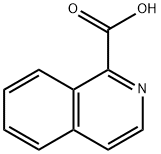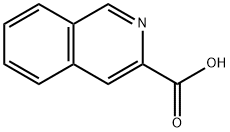Isoquinoline , 97% , 119-65-3
CAS NO.:119-65-3
Empirical Formula: C9H7N
Molecular Weight: 129.16
MDL number: MFCD00006898
EINECS: 204-341-8
| Pack Size | Price | Stock | Quantity |
| 25G | RMB24.00 | In Stock |
|
| 100G | RMB40.00 | In Stock |
|
| 500G | RMB142.40 | In Stock |
|
| 2.5KG | RMB559.20 | In Stock |
|
| others | Enquire |
PRODUCT Properties
| Melting point: | 26-28 °C (lit.) |
| Boiling point: | 242-243 °C (lit.) |
| Density | 1.099 g/mL at 25 °C (lit.) |
| vapor pressure | 5Pa at 20℃ |
| FEMA | 2978 | ISOQUINOLINE |
| refractive index | n |
| Flash point: | 225 °F |
| storage temp. | 2-8°C |
| solubility | 5g/l |
| form | Low Melting Solid |
| pka | 5.42(at 20℃) |
| color | Light brown |
| PH | 7.5 (5g/l, H2O, 20℃) |
| Odor | at 0.10 % in triacetin. sweet balsam herbal benzaldehyde anise |
| Odor Type | balsamic |
| Water Solubility | practically insoluble |
| Merck | 14,5222 |
| JECFA Number | 1303 |
| BRN | 107549 |
| Dielectric constant | 10.7(20℃) |
| InChIKey | AWJUIBRHMBBTKR-UHFFFAOYSA-N |
| LogP | 2.08 |
| Dissociation constant | 5.19 at 25℃ |
| CAS DataBase Reference | 119-65-3(CAS DataBase Reference) |
| NIST Chemistry Reference | Isoquinoline(119-65-3) |
| EPA Substance Registry System | Isoquinoline (119-65-3) |
Description and Uses
Isoquinoline, also known as 2-azanaphthalene, benzo[c]pyridine, or 2-benzanine, is a structural isomer of quinoline. It has structural and spectroscopic properties similar to quinoline. Isoquinoline was first isolated in 1885 by Hoogewerf and van Dorp from the quinoline fraction of coal tar by fractional crystallization. It is used to prepare dyes, insecticides, and antimalarial compounds, among other things.
Isoquinolines are used in the manufacture of dyes, paints, insecticides and antifungals. It is also used as a solvent for the extraction of resins and terpenes, and as a corrosion inhibitor.
Isoquinoline (isq) has been used:
in the preparation of cis-[(dcbH2)2Ru(isq)2](ClO4)2 [dcbH2 = 4,4′-(CO2H)2-2,2′-bipyridine].
to investigate the toxicity of three two-ring and five three-ring azaarenes to the green alga Scenedesmus acuminatus and its relationship with molecular structure.
Safety
| Symbol(GHS) |  GHS06 |
| Signal word | Danger |
| Hazard statements | H302-H311-H315-H319-H412 |
| Precautionary statements | P264-P273-P280-P301+P312-P302+P352+P312-P305+P351+P338 |
| Hazard Codes | T |
| Risk Statements | 22-24-38-52/53-36/38-21/22-45 |
| Safety Statements | 36/37-45-36/37/39-61-53 |
| RIDADR | UN 2811 6.1/PG 3 |
| WGK Germany | 2 |
| RTECS | NW6825000 |
| TSCA | Yes |
| HazardClass | 6.1 |
| PackingGroup | II |
| HS Code | 29334900 |
| Toxicity | LD50 orally in rats: 360 mg/kg (Smyth) |




